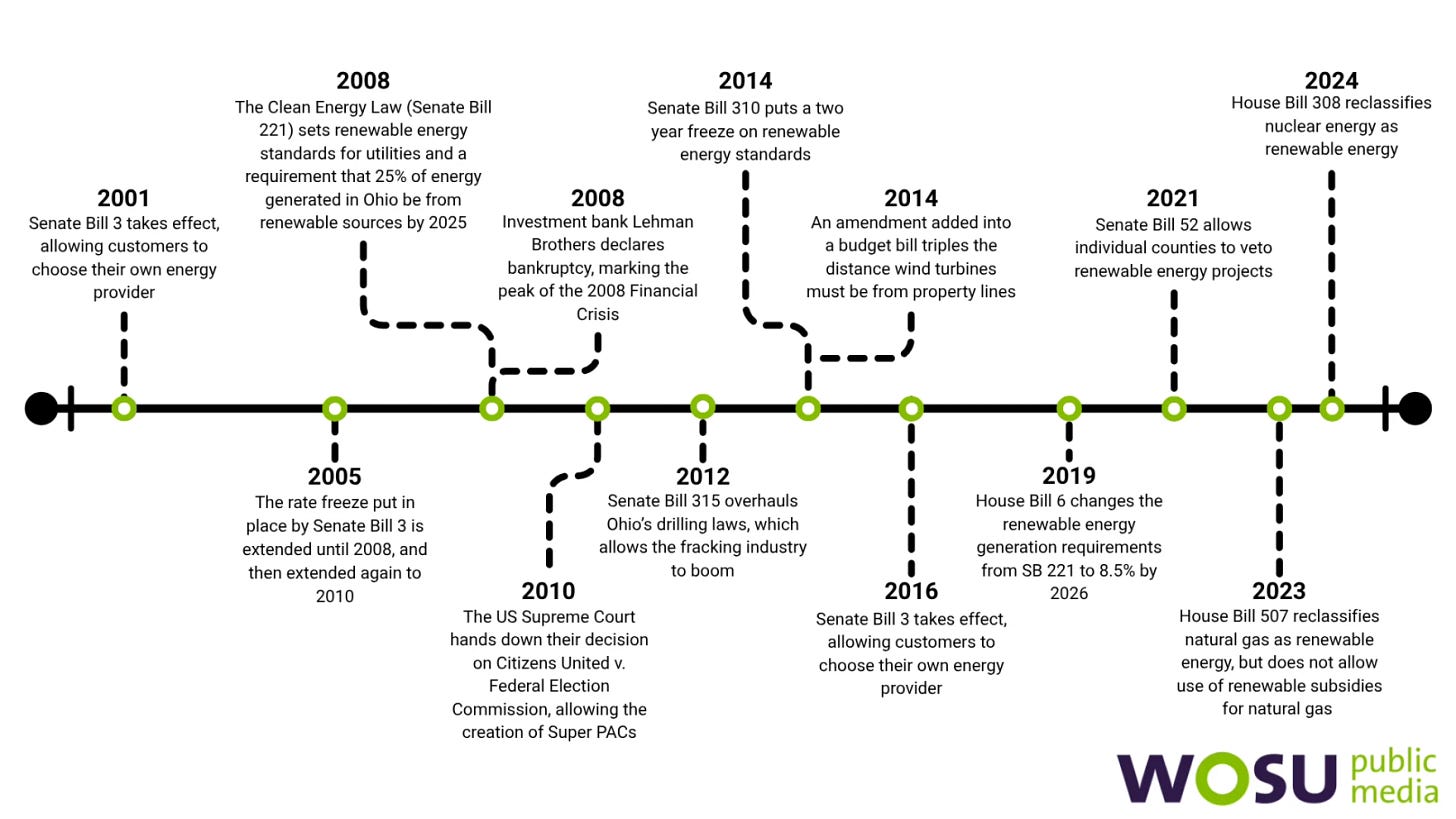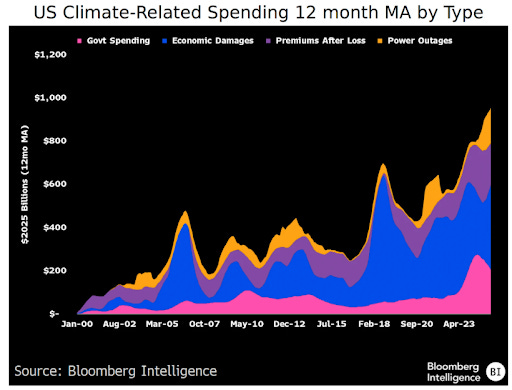Transition Finance Weekly - 10/31/2025
IL Moves Grid Modernization; CA Insurance Addresses Long-Term Solvency; OH Falls Short on 2008 Promise
Exploring the policy, politics, and economics of the clean energy transition
WE WANT TO HEAR FROM YOU. What would you like to see in this newsletter? What kinds of developments would you like us to track? You can reach us at newsletter@pleiadesstrategy.com.
Subscribe to Transition Finance Weekly here. (Tell your friends!)
BREAKING: Last night, the Illinois legislature passed the “Clean and Reliable Grid Act.” SB25 is a comprehensive grid modernization package that will save families and businesses $13 billion on their electricity bills over 20 years and deploy 3GW battery storage, alongside moving forward good planning and transparency efforts. Governor Pritzker pledged to sign the bill.
1. California Insurance Regulator Moves to Ensure Industry’s Long-Term Solvency in the Face of Climate Risks
Draft regulations identify both disclosure and transition planning requirements.
On Monday, the California Department of Insurance (CDI) filed a draft regulation aimed at protecting the long-term fiscal solvency of insurers and improving how climate risk is incorporated and managed in the property insurance system. The regulation, dubbed “Long-Term Solvency Planning,” requires insurers to report to the CDI on transition and climate-related risks — and outline their plan to address identified risks.
Under the proposed rules, insurers would have to stress-test their investment and underwriting portfolios in the long term, a first for California since former Insurance Commissioner Dave Jones conducted the first climate risk-related insurance stress tests in the country, as well as present their plans for navigating the energy transition and increased climate risk.
The proposed rule is also modeled on best practices established by global regulators and the International Association of Insurance Supervisors.
2. “Undisputed” — Judge Rules New York Is Violating Its Own Climate Law
A state judge has ruled that New York agencies must issue greenhouse gas regulations Gov. Kathy Hochul has been delaying.
The decision, issued last Friday by Ulster County Supreme Court Judge Julian Schreibman, found that the state’s Department of Environmental Conservation (DEC) has failed to issue legally required emissions regulations, more than 18 months past the deadline. The 2019 Climate Leadership and Community Protection Act (CLCPA), still one of the most ambitious in the nation, gave the agency until January 2024 to finalize rules ensuring New York met its binding greenhouse gas targets. Schreibman called that failure “undisputed,” and gave the state until February to either obey the law or get it changed.
In court, the DEC argued that drafting the regulations was “infeasible” because it would impose “extraordinary and damaging costs upon New Yorkers.” Gov. Kathy Hochul has made similar claims in shelving her proposed “cap and invest” program. But the judge dismissed those arguments outright, saying the law’s requirements are clear and enforceable.
The ruling follows months of mounting criticism from climate advocates, who say New York has abandoned key commitments under its own climate statute. Now, with the court ordering the state to act, the Hochul administration faces a defining test of whether it will follow through on not just the law, but its own climate rhetoric.
“The cuts in climate pollution promised by this law aren’t optional—they’re essential for our health, our air, and our future,” said Katherine Nadeau, Environmental Advocates NY’s Deputy Executive Director for Policy & Programs. “We urge the Governor and her Administration to move quickly, follow the law, heed the science, and finalize the Clean Air Initiative—New York’s cap-and-invest program—so that New York’s communities can breathe easier.”
3. Surprise! ExxonMobil Tries to Block California’s Climate Transparency Laws
This suit represents the latest chapter in big oil’s fight against basic transparency.
ExxonMobil is suing to block California’s new climate disclosure laws. The Texas-based oil giant filed its complaint last Friday in federal court, seeking to stop the laws from taking effect next year. The measures would require large corporations to disclose their full greenhouse gas emissions, including global operations, and report climate-related financial risks. Exxon, which made $36 billion in profit last year, argues that the rules “place disproportionate blame on large companies like ExxonMobil.”
This case joins an earlier suit by the Chamber of Commerce against the transparency provisions. A motion for preliminary injunction was denied in August and denied again when appealed in September.
California’s disclosure laws —the first of their kind in the country but in alignment with global regulatory trends— are seen as a major step forward in ensuring that investors and other key decision makers have the information they need to assess exposure to material climate and energy transition risks.
“Truly shocking that one of the biggest polluters on the planet would be opposed to transparency,” said a spokesperson for CA Gov. Newsom.
4. Deadline Is Here, Let’s Check the Receipts: Ohio’s 2008 RPS
Once-bipartisan clean energy law eroded in implementation by fossil incumbents.
Back in 2008, Ohio lawmakers legislated a bold, bipartisan target: 25% renewable energy by 2025. Today, with that deadline here, the state’s renewable share sits at just 5%, one of the lowest in the nation.
Over the last decade, Ohio’s Republican-led government has systematically dismantled its own clean energy policies, replacing them with policies that protect fossil fuels and pass higher costs on to residents. In 2019, lawmakers gutted the state’s renewable portfolio standard (RPS), slashing the target to 8.5% by 2026. That same year, the legislature became embroiled in the House Bill 6 corruption scandal, which saw the House Speaker bribed by FirstEnergy representatives to bailout expensive aging coal plants.
Since then, the hits have kept coming: SB 52 (2021) lets counties ban wind and solar projects outright, HB 507 (2023) absurdly reclassified natural gas as “renewable,” HB 308 (2024) followed by labeling nuclear power as renewable too, and earlier, a 2014 law tripled wind turbine setbacks, effectively freezing new wind projects.
“It’s very frustrating how far ahead we could be,” said Mark Shanahan, former head of the Ohio Air Quality Development Authority.
5. Climate Disasters Are Rewiring the US Economy by $1 Trillion/Year
With disaster recovery now big business and insurance costs up, every household is carrying costs traced to climate change.
In the last year alone, the U.S. has racked up nearly $1 trillion in disaster costs, according to Bloomberg, a record high that amounts to more than 3% of the nation’s GDP. Fires, hurricanes, and flooding aren’t just devastating communities; they’re functioning as a stealth tax on consumer spending, siphoning off an estimated $80 billion a month from other parts of the economy.
Nowhere are the impacts clearer than in places like western North Carolina, where last fall’s Hurricane Helene triggered deadly floods and mudslides that killed more than 100 people and left behind nearly $60 billion in damage. Federal and state agencies poured billions into recovery efforts, yet the rebuilding costs keep climbing, and insurance premiums continue to soar.
As federal support for mitigation and recovery funding wanes — with key programs at HUD and FEMA being rolled back — those costs aren’t going away. They’re simply being shifted onto households and the private sector, driving up everything from insurance rates to energy bills.
6. DOE Pushes FERC to Protect Power Consumers, Not Just Generators
If successful, these rules could mark a major step toward a fairer, more reliable grid.
The Department of Energy has directed the Federal Energy Regulatory Commission (FERC) to create first-of-their-kind standardized federal rules for the interconnection of large loads, such as data centers and industrial facilities.
The DOE’s filing would standardize interconnection procedures and requirements for large loads, an area usually handled at the state level with far less regulation than power generators face when they interconnect. The move aims to protect ratepayers and the grid from unconstrained growth in electricity demand while giving large customers a pathway to connect more quickly, if they agree to provide “bounded flexibility” to grid operators.
The filing has already received positive signals from both former and current FERC commissioners, suggesting broad support. Still, how the proposal process plays out will matter, especially given recent indications of the administration’s desire to politicize and weaponize independent commissions like the FTC and FCC.
“No matter where one stands on the jurisdictional debate, there should be broad agreement that every U.S. jurisdiction needs a viable, expedited service tier for large electricity customers willing to provide bounded flexibility to grid operators in exchange for faster interconnection,” said energy analyst Tyler Norris.
SPOTLIGHT: California’s Wraps Another Summer Without a Single Flex Alert
In 2025, renewable energy sources supplied more than 100% of California’s electricity demand on 206 days, according to grid data. The state’s vast installed base of batteries — now totaling more than 52 gigawatt-hours of capacity, triple that of any other U.S. market — is playing a decisive role in keeping the lights on. When the sun dips and demand spikes, those batteries push stored solar power back onto the grid, slashing reliance on gas plants and driving fossil gas use for electricity down nearly 40%.
The result: a cleaner, more resilient power system that hasn’t had to call upon customers to flex their power usage — once a summer rite of passage — to make ends meet on the hottest days of the sunny season.









Thank you for keeping us informed.